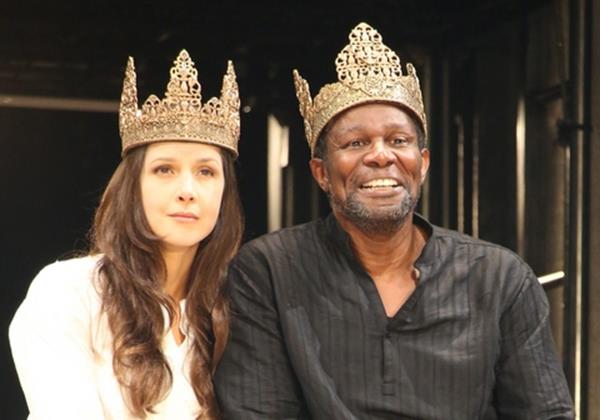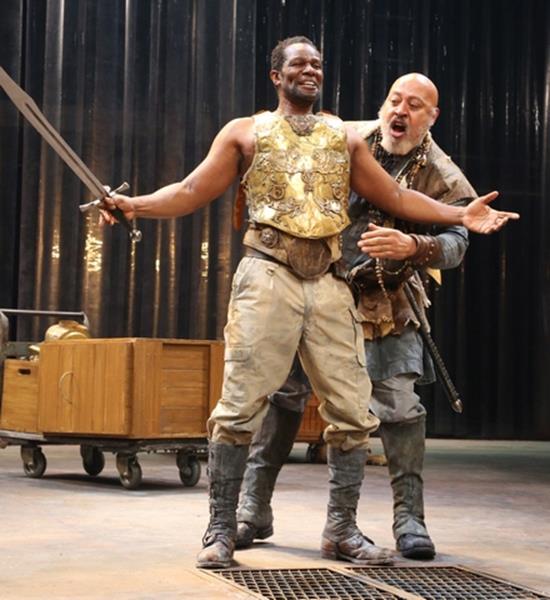Tamburlaine, Parts I and II
Ambitious revival of Marlowe's play cycle gives John Douglas Thompson a bravura role as the nomadic tyrant but production is both unimaginative and pallid.

Merritt Janson and John Douglas Thompson in a scene from “Tamburlaine, Parts I and II” (Photo credit: Gerry Goodstein)
[avatar user=”Victor Gluck” size=”96″ align=”left” ] Victor Gluck, Editor-in-Chief[/avatar] Theatre for a New Audience is to be commended for dauntlessly and intrepidly staging Christopher Marlowe’s two part, ten act Tamburlaine on one evening in a new adaptation by Michael Boyd, former director of the Royal Shakespeare Company. A search of the Internet does not show any other New York revivals of both parts on the same evening.
Often credited as the play that proved to the Elizabethans that blank verse was the way to go with stage tragedy, it also heavily influenced contemporary William Shakespeare whose own history plays all followed this play by Marlowe. Performed in three hours with one 30 minute intermission, this Tamburlaine is truly epic in scope. Boyd’s production stars John Douglas Thompson who after acclaimed performances in Shakespeare’s Othello, Macbeth, Antony and Cleopatra, and King Lear, as well as O’Neill’s The Emperor Jones, has become one of our finest tragedians.
Unfortunately, the evening is not the success that one would have wished for. Although the play travels all over the Ottoman Empire, Persia and Central Asia during the 14th and 15th centuries, there is no sense of atmosphere. While Elizabethan productions used little or no scenic elements, they made up for it with gorgeous costuming and pageantry. Boyd’s staging with sets and costumes by Tom Piper is mainly in black, white and grey and consequently adds little to the visual element. The lighting by Matthew Richards fails to become a character on the almost bare stage. With a cast of 19, the stage often looks underpopulated for this Elizabethan epic.
As the play is a brutal study of a tyrannical ruler, there are many death scenes. It has been Boyd’s conceit to have a child actor carrying a pail throw “red blood” over the victims rather than staging the confrontations to the end. At first this is startling and original, but as the victims pile up, this device becomes predictable and ultimately tedious. Even with the unusually large cast, a great many of the actors must double in often more than two roles. Little is done with costuming or wigs to disguise the actors when they reappear so that we can distinguish one character from the other.
The most damning problem with Marlowe plays, which may explain why they are not performed as often as those of Shakespeare, is that there is little psychological depth or motivation. Tamburlaine convincingly becomes “the scourge of God” but we never find out what motivated him or his back story. Characters may have soliloquies but they are mainly descriptive, offering little character development. A steady diet of the major works of the Bard of Avon has caused us to expect depth of character in our verse tragedies.
Marlowe’s Tamburlaine is based on the historic Timur the Lame, the last of the nomadic Asian conquerors, who ruled from 1370 – 1405. The play begins in Persia when the Emperor Mycetes sends troops to capture Tamburlaine, a Scythian shepherd turned marauder. In Scythia, Tamburlaine captures Zenocrate, the daughter to the Soldan of Egypt, and vows to make her his wife. Confronted with the Persian forces under Theridamas, Tamburlaine convinces them to join him and he becomes Emperor of Persia.
Next he turns to Bajazeth, Emperor of the Turks, and his tributary Kings of Fez, Morocco and Argier. After capturing him and his Queen Zabina, Tamburlaine keeps them in cages and gives the tributary kingdoms to his followers Techelles, Theridamus and Usumcasane. During Tamburlaine’s siege of Damascus, his army is set upon by the Soldan of Egypt and the King of Arabia, Zenocrate’s former fiancé. She begs him to spare her father which he does and after his successful outcome, he marries Zenocrate with the blessing of the Soldan, crowning her Queen of Persia.
Part II begins with King Orcanes of Natolia joining forces with the Christian King Sigismund of Hungary against their common enemy Tamburlaine. Sigismund then breaks his oath and Orcanes kills him. When Tamburlaine’s Queen Zenocrate falls ill and dies, Tamburlaine orders her body to be put in a coffin which he will keep with him at all times. Callapine, son of King Bajazeth, escapes and is crowned Emperor of Turkey by Orcanes and they resolve to defeat the seemingly unstoppable tyrant. Tamburlaine’s forces meet the Turks at Aleppo where his sons Celebinus and Amyras fight bravely, but finding that his son Calyphas has remained behind, he kills him for his cowardly behavior.

sven days a John Douglas Thompson and Keith Randolph Smith in a scene from “Tamburlaine, Parts I and II”(Photo credit: Gerry Goodstein)
The conquered Kings of Trebizon and Soria are made to draw his chariot as Tamburlaine attacks and overthrows Babylon. Here Tamburlaine commits his greatest atrocities, drowning the entire population of the city. Burning the city’s holy books, he claims to be greater than God and is almost immediately struck by an illness which kills him.
The first part of Tamburlaine follows a pattern of battles and killings which becomes monotonous after a while. However, the second part which is more varied and has more domestic scenes creates additional interest. On the other hand, it is not possible to have any sympathy for the play’s titular hero due to the piling up of acts of barbarism which become more and more creative and vicious but also become too much to take in. While Thompson is at all times a commanding figure, his Tamburlaine never changes or develops but remains the same throughout with little or no variety, which is partly the fault of Marlowe’s text. At the performance under review, Thompson’s famous baritone voice was hoarse throughout the evening, though whether this was due to indisposition, the strain of the continued three-hour seven-day-a-week performance schedule, or ageing, it is not known.
Some of the cast play characters of the opposite sex. While it is obvious who they are playing from how they are addressed, visually this makes for a certain amount of confusion. Tamburlaine’s three sons played by James Udom, Zachary Infante and Vasile Flutur could not be more different, making it difficult to think of them as brothers. Merritt Janson as Zenocrate, Tamburlaine’s queen, is imperious but as the play does not explain how she is won over by the tyrant, her conversion leaves a great deal unexplained. Among the large cast, Paul Lazar as two inept and comic kings is amusing in a play that offers no comic relief, while Andrew Hovelson, Keith Randolph Smith and Carlo Alban are fine as Tamburlaine’s loyal followers. Arthur Solari is responsible for both composing the exotic original music as well as performing it on percussion throughout the evening.
While Boyd’s script skillfully edits the two parts of Tamburlaine into one evening, many of his choices leave a great deal to be desired, nor does he deal with the fact that the continual piling up of atrocities is eventually numbing for an audience in so long a play. Catch the Theatre for the New Audience production as it may be your only opportunity to see both plays as one in New York City, but it does not make a case for Marlowe as a worthy rival to the history plays and tragedies of Shakespeare.
Tamburlaine, Parts I and II (through January 4, 2015)
Theatre for a New Audience’s Polonsky Shakespeare Center
Samuel H. Scripps Mainstage, 262 Ashland Place, at Fulton Street, in Brooklyn
For tickets, call 866-811-4111 or visit http://www.tfana.org
Running time: three hours and 30 minutes including one 30 minute intermission






Leave a comment